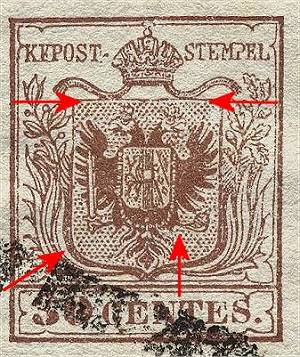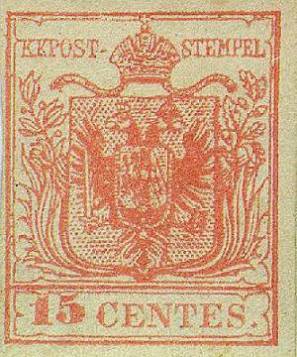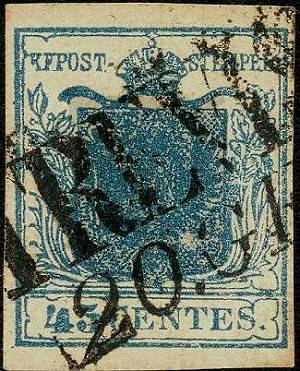By
introducing the first issue of the Lombardy-Venetia it has been highlighted
how do exist several types and sub-types of various stamps, that differ for
small details.
Between the various elements that get a "maquillage" one of the
most important, if not the most important, is the central coat of arms.
The usage of the printing plates, that were used to produce a huge number
of parts, brought a quick and very visible wear of the plates themselves,
from which came out a constant degrading of the final quality of the stamps
that became more and more bad looking and muddy to the viewer.
For this reason the "original" coat of arms and, in particular,
the background dots were remade: this operation is called "revisiting"
or "re-engraving" operation.
Here in schematic way I show what type of coat of arms can be found in each
value.
|
Stamp
|
Type/Subtype
|
Paper
type
|
Coat
of arms type
|
|
5
centesimi
|
-
|
Handmade
|
Original
|
|
5
centesimi
|
Recto
- verso
|
Handmade
|
Original
|
|
10
centesimi
|
-
|
Handmade
|
Original
|
|
10
centesimi
|
-
|
Machine
made
|
Cleaned
|
|
15
centesimi
|
1st
|
Handmade
|
Original
|
|
15
centesimi
|
2nd
- vermilion
|
Handmade
|
Original
|
|
15
centesimi
|
2nd
- pink
|
Handmade
|
Original
|
|
15
centesimi
|
3rd
|
Handmade
|
Cleaned
|
|
15
centesimi
|
3rd
|
Machine
made
|
Cleaned
|
|
15
centesimi
|
1st
|
Ribbed
|
Original
|
|
15
centesimi
|
2nd
|
Ribbed
|
Original
|
|
15
centesimi
|
3rd
|
Laid
|
Cleaned
|
|
30
centesimi
|
1st
|
Handmade
|
Original
|
|
30
centesimi
|
2nd
- dark brown
|
Handmade
|
Cleaned
|
|
30
centesimi
|
2nd
- lilac brown
|
Handmade
|
Cleaned
|
|
30
centesimi
|
2nd
|
Machine
made
|
Cleaned
|
|
30
centesimi
|
1st
|
Ribbed
|
Original
|
|
45
centesimi
|
1st
|
Handmade
|
Original
|
|
45
centesimi
|
2nd
- slate blue
|
Handmade
|
Original
|
|
45
centesimi
|
2nd
- blue
|
Handmade
|
Cleaned
|
|
45
centesimi
|
1st
|
Ribbed
|
Original
|
|
45
centesimi
|
2st
|
Machine
made
|
Cleaned
|
The more obvious question is now how to distinguish the two coat of arms types...
I show here two stamps: the left part has the original coat of arms while the one to the right has the revisited one (Fig 1 - 1a).
 |
 |
|
Fig.
1: "ORIGINAL" coat of arms
|
Fig.
1a: "CLEANED" coat of arms
|
Here listed are the main differences between
the two coats of arms:
In the high part of the original coat of arms we can see a clean thin
white line without the presence of dots on the background, in the
revisited one this line is often non existent and occupied by dots;
sometimes nevertheless this white space is found also in the revisited
coat of arms (for instance in 30 centesimi of the second type is often
there). |
In
the original coat of arms the two dots under the eagle right paw are
always connected creating a small curved line. In the revisited one
the two dots are always separated. This is may be the main detail
to identify the two types. |
In
the original coat of arms the lower curve of the shield and the first
external leave are often (but not always) connected and form a thick
and full of color curve; in the revisited coat of arms that curve
looks sometimes not full and we can see some white space between the
shield and the first leave of the border. |
Several other very small details differ between the two coats of arms but
the elements just mentioned, together with all the others that characterize
the first issue stamps (type, sub-type, color, printing, spacing, paper
etc) make the identification relatively simple.
It should anyway outlined how in samples with very heavy or smeared inking
the drawing details tend to connect to each other and to be not so identifiable.
Even in this case a bit of experience and the possibility of comparison
between several samples are very useful (Fig. 2).

Fig. 2:
an original coat of arms that... is not so original!
In cases like this one the determination of the coat of arms type
should be made by considering other elements (paper, type, printing etc)
This sample shows also the variety "coat of arms in relief" described
in another "Going Deep".